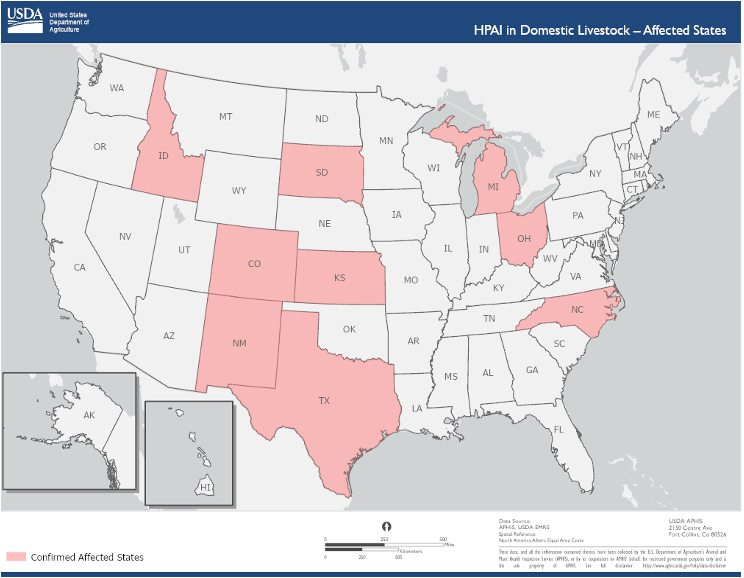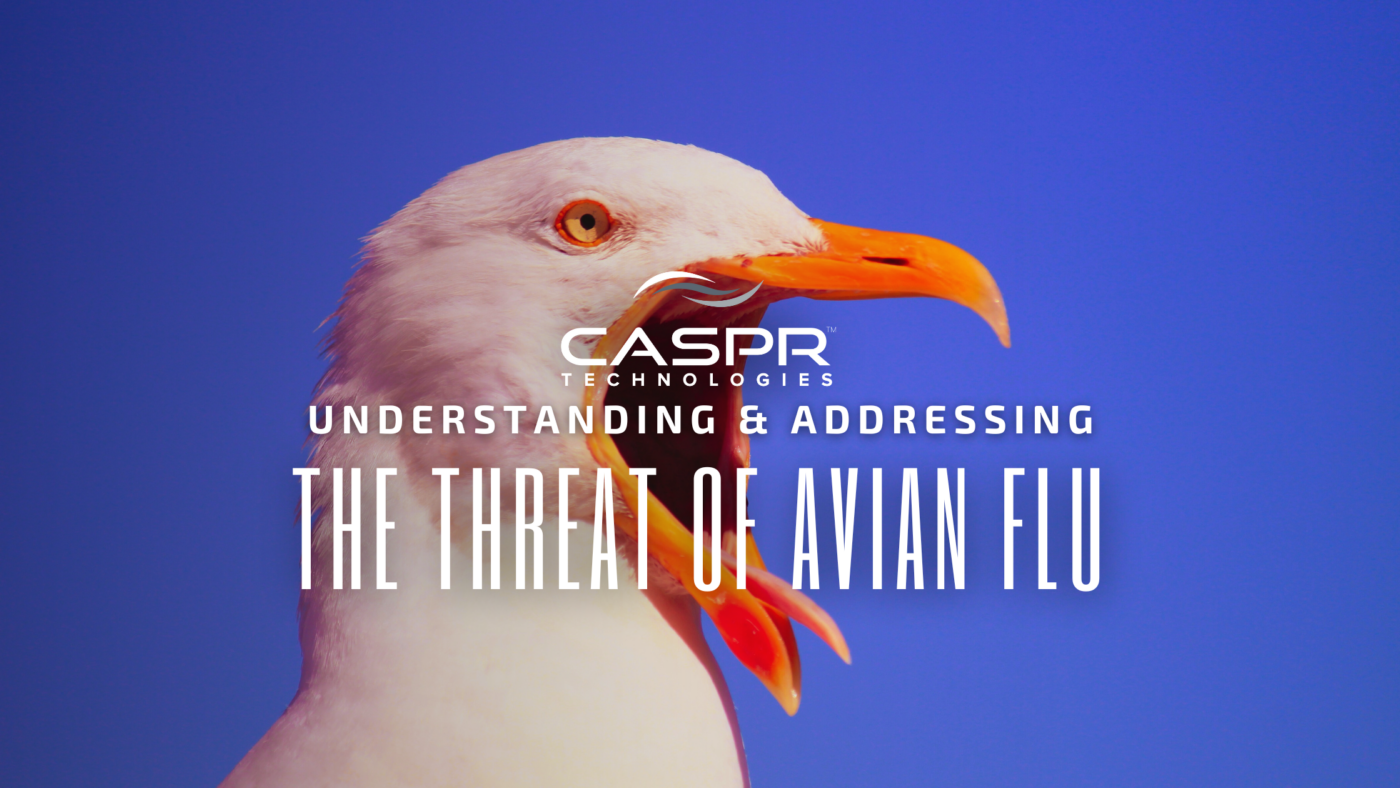Recent reports about avian flu, particularly the H5N1 strain, have emerged, with more than 40 cattle facilities testing positive since March 2024, as of this writing. About 20 percent of retail milk tested is positive for the virus.1 Therefore, avian flu poses a significant threat to animal health and a potential threat to human health. Global experts have been closely monitoring this threat, now reality, since 2020.
While only one symptomatic case of avian flu among a farm worker in Texas was investigated last month, experts are closely watching to monitor other farm workers with surveillance testing, and assessment of any symptoms of illness. Concerns about the potential threat of human-to-human transmission has been expressed, with the CDC (Centers for Disease Control and Prevention) now testing wastewater supplies to detect any spikes in flu that could be attributed to Avian Flu. 2
Originally detected among poultry and wild birds, avian flu virus or highly pathogenic avian influenza (HPAI) spreads rapidly, expanding its reach, infecting various animal species. During fall and spring wild bird migrations, avian flu cases can be expected to rise, particularly in-flight migration zones. This is why the US government allocated 200 million dollars towards a rapid response to the spread of avian flu this month. 3

How quickly the virus has spread this year has surprised scientists, with this outbreak believed to have begun in December 2023. The origins of bird flu trace back to China’s Guangdong region in 1996, where a new highly pathogenic strain, H5N1, was first identified in a farmed goose. By 1997, the first human deaths from avian flu transmitted among farm workers were reported in Hong Kong. Since then, it has expanded its reach, infecting other animal species. Low pathogenic avian influenza, initially non-fatal in wild birds, can mutate into different strains of HPAIs in farm-raised poultry. HPAIs can, cause severe illness and death among birds. 4
Even in remote regions of the world, there is evidence for the global spread of avian flu. These include HPAIs found among wild birds in Antarctica’s Northern Weddell Sea. Veterinary pathologists, like Lineke Begeman, have been at the forefront, braving harsh conditions to analyze the impact of the virus on wildlife. 4 Their efforts provide crucial insights into the virus’s trajectory and its potential consequences. For more than two decades, global and US national public health authorities, defense and civil authorities have worked on avian flu preparedness and response.
How it Spreads: Bird flu viruses can infect humans when a sufficient amount of the virus enters a person’s eyes, nose, or mouth, or when inhaled. This transmission can occur through airborne virus particles, such as droplets or potentially dust, that are breathed in by a person. Additionally, transmission can occur when a person touches a surface contaminated with the virus and then touches their mouth, eyes, or nose. 5
Human infections with bird flu viruses typically occur following close, prolonged, and unprotected contact with infected birds. In such instances, individuals may encounter the virus through direct exposure to infected birds or their bodily fluids, such as saliva, mucus, and feces.5 Within poultry facilities, feces may dry out and become airborne during activity. These can be inhaled by workers in some facilities. Protective measures, such as gloves or other personal protective equipment (PPE), are essential to reduce the risk of infection during contact with infected birds or contaminated surfaces.
Prevention
Preventing avian flu requires avoiding exposure to sick or dead animals and birds, especially poultry. Protective measures, such as wearing gloves, masks or face shields and other appropriate PPE, are essential when farm workers are handling potentially infected animals. Intermittent cleaning and sanitation of surfaces is important. 5 Continuously operating engineering products can provide an extra layer of protection for reducing both air and surface contamination, like CASPR (Continuous Air & Surface Pathogen Reduction). Hazard and risk reduction is the goal of prevention activities customized for facilities.
Impact and Response
While human cases of avian flu remain rare at this writing, the mortality rate among those people infected is disturbingly high, exceeding 50%. However, the virus’s impact on animals has been devastating, leading to the slaughter of millions of farmed birds every year since 2020, mostly in Asia. In addition, avian flu is causing significant mortality among wild bird populations. 4 To assist in mitigation strategies, the US Department of Agriculture shared data, obtained through routine collections of wild bird samples, that identifies areas with an increased AIV risk. 6
Efforts to prevent avian flu include enhanced surveillance, biosecurity measures on farms, and vaccination programs with some strains to poultry in high-risk areas. However, challenges remain, including the reluctance of some nations to implement vaccination, due to trade barriers, loss of income to farmers and producers when birds found to be positive are slaughtered, and concerns about disease detection in vaccinated flocks.
Since March, the detection of H5N1 among dairy cows in the United States underscores the need for comprehensive monitoring and response strategies for the remainder of this year, and beyond. While the transmission of the virus to humans remains rare, the potential for animal to human transmission highlights the importance of vigilant surveillance and implementation of public health measures to limit the spread.
The Importance of Monitoring Spread
All the commercial milk supply in the U.S. comes from farms that participate in the Grade “A” milk program and follow the Pasteurized Milk Ordinance (PMO), ensuring safety. Pasteurization and diversion or destruction of milk from sick cows are crucial measures in the federal-state milk safety system.

As of May 10, the USDA states that 46 facilities have tested positive, with 1 in 5 retail milk samples analyzed being positive for the virus on May 2, 2024. 7 The virus has been reported to spread from cattle to other mammals, namely a few barnyard cats and a raccoon, in addition to poultry and wild birds. This impacts food safety and security.
Evidence to date indicates that adaptation of the HPAI A(H5N1) virus has occurred, since it has become established among cows. What worries many epidemiologists is the risk to public health, should the virus continue to affect other parts of the food supply, such as pigs. Unlike cattle, pigs often are infected with other influenza A viruses and are genetically closer to being able to infect humans. A few of these influenza viruses have already adapted and infected humans. Should these pig viruses mutate or exchange genetic material with H5N1, a more virulent strain of the virus or even a pandemic strain is possible. Therefore, extra measures are needed to limit the spread of HPAI to pigs, and to carefully monitor pig populations for HPAI.
Recommendations and Conclusion
The FDA recommends against consuming raw milk or raw milk products, particularly from cows showing symptoms of illness or exposure to avian influenza viruses. Producers are urged to take precautions when discarding milk from affected cows to prevent further spread. Destruction of poultry in affected facilities is made with appropriate state and national food/agricultural safety workers and veterinarians.
For the last two decades, public health authorities have been developing preparedness plans to combat avian flu as a global health concern. Now, these are being utilized, along with the mobilization of funding for US activities. 8 The recent, rapid emergence and spread of HPAI is a cause for concern, necessitating urgent action for monitoring and surveillance of poultry and pig production farms, while escalating adherence to safety protocols. While human to human transmission has not been reported with this HPAI, efforts are underway and continuing to monitor and limit any additional mutations of HPAIs among animals that could potentially impact humans. The CDC asks health officials to maintain flu surveillance this summer despite transmission of seasonal flu viruses dropping to minimal levels in the Northern Hemisphere. Even in the off-season, staying alert of any signs of human-to-human spread will minimize the risk 9 of H5N1 transmission. Continued collaborative action among food production facilities, public health authorities, communities and civil authorities are essential to safeguard both the food supply and human susceptibility to any further HPAI mutations.
The timeline of H5N1’s global spread 4
1996: Detected in poultry in Guangdong, China
1997: First human deaths reported in Hong Kong
2005: Spilled over into wild birds in a major way; new strains emerge
2020: A strain emerges that can sustain in wild bird populations year-round
2020-22: Becomes endemic in wild bird populations
2021: Arrives in North America
2022: Detected in South America
2024: Confirmed in Antarctica
Resources
Bird Flu Outbreak in Dairy Cows Is Widespread, Raising Public Health Concerns | Infectious Diseases | JAMA | JAMA Network
https://www.reuters.com/business/healthcare-pharmaceuticals/cdc-makes-public-influenza-wastewater-data-assist-bird-flu-probe-2024-05-14/
https://www.reuters.com/business/healthcare-pharmaceuticals/us-provide-nearly-200-million-contain-bird-flu-spread-dairy-farms-2024-05-10
https://www.bbc.com/future/article/20240425-how-dangerous-is-bird-flu-spread-to-wildlife-and-humans
https://www.cdc.gov/flu/avianflu/prevention.htm#anchor_1647619154182
https://www.aphis.usda.gov/livestock-poultry-disease/avian/avian-influenza/wild-bird-surveillance-dashboard
https://www.bbc.com/future/article/20240510-bird-flu-in-cows-has-caused-concern-amongst-milk-drinkers-experts-say-its-still-safe-to-drink
Updates on Highly Pathogenic Avian Influenza (HPAI) | FDA
Citing H5N1 threat, CDC urges peak flu monitoring this summer – STAT (statnews.com)

